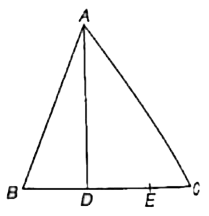Let ABC be an equilateral triangle. If the side BC is produced to the point D so that BC = 2CD, then AD2 is equal to
3CD2
4CD2
5CD2
7CD2
To solve the problem, we need to find AD2 in terms of CD given that BC is produced to point D such that BC=2CD.
Step 1: Understand the Triangle and Given Conditions
Let ABC be an equilateral triangle. We know that in an equilateral triangle, all sides are equal, and all angles are 60∘. We are given that BC is extended to point D such that BC=2CD.
Step 2: Define Variables
Let:
- CD=x
- Then, BC=2x
Step 3: Find Lengths in the Triangle
Since M is the midpoint of BC:
- BM=MC=x (because BC=2x)
Step 4: Calculate the Height of the Triangle
The height AM of the equilateral triangle ABC can be calculated using the formula for the height of an equilateral triangle:
AM=√32×BC=√32×2x=√3x
Step 5: Use the Median Property
In triangle AMD, we can use the property of the median. The median divides the opposite side into two equal segments. Thus, we can set up a ratio:
AMMC=ADCD
Substituting the known values:
√3xx=ADx
This simplifies to:
√3=ADx
Thus, we can express AD as:
AD=√3x
Step 6: Substitute x with CD
Since x=CD, we have:
AD=√3⋅CD
Step 7: Calculate AD2
Now we can find AD2:
AD2=(√3⋅CD)2=3⋅CD2
Final Answer
Thus, AD2 is equal to:
3CD2
Let ABC be an equilateral triangle. We know that in an equilateral triangle, all sides are equal, and all angles are 60∘. We are given that BC is extended to point D such that BC=2CD.
Let:
- CD=x
- Then, BC=2x
Since M is the midpoint of BC:
- BM=MC=x (because BC=2x)
The height AM of the equilateral triangle ABC can be calculated using the formula for the height of an equilateral triangle:
AM=√32×BC=√32×2x=√3x
In triangle AMD, we can use the property of the median. The median divides the opposite side into two equal segments. Thus, we can set up a ratio:
AMMC=ADCD
Substituting the known values:
√3xx=ADx
This simplifies to:
√3=ADx
Thus, we can express AD as:
AD=√3x
Since x=CD, we have:
AD=√3⋅CD
Now we can find AD2:
AD2=(√3⋅CD)2=3⋅CD2
Thus, AD2 is equal to:
3CD2
Similar Questions
Knowledge Check
In an equilateral triangle ABC, the side BC is trisected at D. Find the value of AD2 :
 A97AB2B79AB2C34AB2D45AB2
A97AB2B79AB2C34AB2D45AB2In an equilateral triangle ABC, the side BC is trisected at D. Then the correct relation is
A9AD2=7AB2B8AD2=9AB2C7AD2=9AB2Dnone of theseIn an equilateral triangle ABC, the side BC is trisected at D. Then the correct relation is
A9AD2=7AB2B8AD2=9AB2C7AD2=9AB2DNone of these
ΔABC is an equilateral triangle. Point D is on side BC such that BD=15BC then prove 25AD2=21AB2.
View SolutionIn ΔABC, AC = BC and ∠ABC=50∘, the side BC is produced to D so that BC = CD then the value of ∠BAD is
View SolutionIf ABC is an equilateral triangle and D is a point on BC such that AD⊥BC, then
View SolutionLet ABC be an equilateral triangle. Let BE⊥CA meeting CA at E, then (AB2+BC2+CA2) is equal to :
View SolutionIn ΔABC,IfAD⊥BC, then AB2+CD2 is equal to
View Solution
